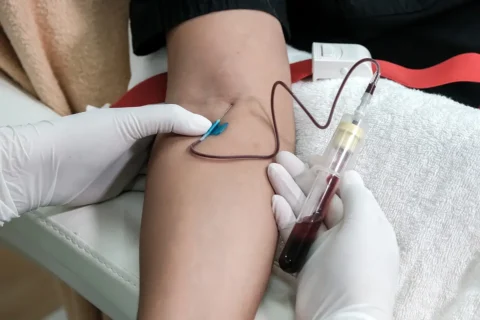Tirzepatide vs. Semaglutide for Diabetes and Weight Loss
When it comes to managing type 2 diabetes, we’ve got more options than ever before. The latest additions to the diabetes drug lineup are tirzepatide (brand name Mounjaro) and semaglutide (brand name Wegovy).
These new medications are like cousins in the glucagon-like peptide-1 (GLP-1) receptor agonist family. They both mimic the effects of GLP-1, a hormone released from your gut that stimulates insulin secretion. But they have some key differences that set them apart from each other.
Tirzepatide is the fresh face bursting onto the scene. This dual agent not only activates the GLP-1 receptor like its cousin semaglutide, but it also binds to another receptor called GIP.
Imagine semaglutide as a key that unlocks one door, while tirzepatide is a swiss army knife that can open two different doors.
By having more tools in its toolbox, tirzepatide seems to pack more of a punch when it comes to lowering blood sugar and slimming waistlines.
Clinical trials have shown tirzepatide can drive A1C levels down further and help people lose more weight compared to semaglutide. It’s like tirzepatide causes bigger ripples in the diabetes pond.
Let’s explore the ways tirzepatide and semaglutide are similar, how they differ, and whether one has the edge when it comes to treating diabetes and losing weight. By the end, you’ll have a better feel for which option might suit you or your patients best.
A Peek Inside: How Do Tirzepatide and Semaglutide Work Their Magic?
To understand why tirzepatide and semaglutide have different effects, we need to look under the hood at their mechanisms of action.
Semaglutide is like a single-function robot – its only job is to activate the GLP-1 receptor. It binds to the receptor and imitates the effects of GLP-1, a hormone naturally produced by your gut after meals.
Activating the GLP-1 receptor stimulates the release of insulin from the pancreas, suppresses glucagon secretion, and delays stomach emptying. All of these effects together lower blood glucose levels.
Tirzepatide is more like a multi-tool Swiss army knife. It not only activates the GLP-1 receptor like semaglutide, but also has a special component that unlocks another receptor called GIP. Tirzepatide binds to and activates the GIP receptor similar to natural GIP.
By having dual effects, tirzepatide provides a one-two punch against diabetes. Stimulating both the GLP-1 and GIP receptors at the same time leads to greater insulin release and glucagon suppression compared to targeting only one. It’s like pressing down on the gas and brake pedal together vs just the gas or brake alone.
The added GIP receptor activation gives tirzepatide a leg up over semaglutide when it comes to lowering blood sugar. And the weight loss benefits of tirzepatide also seem to be augmented by its multi-receptor mechanism.
So in a nutshell, tirzepatide aims at two targets, while semaglutide only has one bullseye. More targets equal greater effects!
Approved Uses: What’s the Prescription for These Meds?
When it comes to formal approved indications, semaglutide has a slight edge over the newcomer tirzepatide – for now, at least.
The FDA has given semaglutide the green light for managing both type 2 diabetes and obesity. So doctors can officially prescribe semaglutide (Wegovy) for patients with:
- Type 2 diabetes (to lower blood sugar)
- Obesity, defined by having a BMI over 30
- Overweight (BMI over 27) with at least one weight-related condition like hypertension
Tirzepatide so far is only approved for use in type 2 diabetes, as an add-on to diet and exercise. But you can bet your bottom dollar that tirzepatide will soon join the obesity medication party once more data accrues.
In the meantime, doctors are already prescribing tirzepatide “off-label” for weight loss in overweight patients, similar to semaglutide. And emerging research suggests both medications could also be useful for treating non-alcoholic fatty liver disease.
How Well Do They Work? Weighing the Benefits

When it comes to lowering A1C and slimming waistlines, head-to-head clinical trials have shown that tirzepatide seems to outperform semaglutide.
In the A1C-lowering competition, tirzepatide appears to take home the gold medal. Trials directly comparing the medications found that tirzepatide could reduce A1C levels more substantially compared to semaglutide. At the maximum doses tested, tirzepatide lowered A1C by 2.34% versus only 1.86% with semaglutide. That’s almost a half point extra reduction!
For weight loss, tirzepatide also seems to hold an advantage. In the battle of the bulge, tirzepatide led to about 3 kg (7 pounds) greater weight loss over semaglutide in head-to-head studies. At the highest doses, patients taking tirzepatide lost around 10.5 kg on average compared to 7.6 kg for semaglutide.
The enhanced effects of tirzepatide are likely due to its dual mechanism of action. With keys to unlock both the GLP-1 and GIP receptor doors, tirzepatide simply seems to pack more of an anti-diabetes punch.
That said, both medications clearly help control blood sugar and spur weight loss in a dose-dependent manner. And not every patient can tolerate the maximum doses where tirzepatide really separates itself from semaglutide. So real-world results may show smaller differences between the two.
Are There Any Potential Drawbacks?
While tirzepatide edges out semaglutide in efficacy, the boost in benefit comes at the cost of increased side effects. That’s often the tradeoff with more potent medications.
Both semaglutide and tirzepatide commonly cause gastrointestinal problems like nausea, vomiting, diarrhea, and appetite/weight loss. But the incidence and intensity of these side effects tend to be higher with tirzepatide across clinical trials.
For example, in one study 21% of patients on tirzepatide reported nausea compared to only 12% on semaglutide. Vomiting occurred in 12% of the tirzepatide group vs 7% for semaglutide.
Why does tirzepatide have more GI issues? Experts think it relates to the medication’s stronger efficacy signaling. Just like revving a car engine harder makes more noise, stimulating the GLP-1 and GIP receptors to a greater degree ramps up side effects originating in the gut.
Beyond GI problems, both meds may also cause headache, fatigue, constipation, gallbladder disease, low blood sugar, pancreatitis, and other issues in a small subset of patients. Serious risks are rare, but require caution and monitoring.
So in return for better diabetes and weight control, tirzepatide asks patients to endure more nausea, vomiting, and other tummy troubles. That’s a tradeoff some find worthwhile, while others can’t tolerate.
Cost and Accessibility
Being the new kid on the block, access to tirzepatide is a bit more limited and pricier compared to semaglutide right now. But that gap is likely to close over time.
Tirzepatide was just approved by the FDA in May 2022, so many insurers are still evaluating coverage criteria. It may take a year or more for formulary access to expand. In the meantime, copay support programs can reduce out-of-pocket costs for eligible patients.
Semaglutide has been around since 2017, so it is more widely covered. Lower-cost generic versions of semaglutide are also beginning to become available, improving affordability.
Without insurance, tirzepatide costs over $1000 per month, while semaglutide runs $800 or more. But with coverage, copays can range from $15 to $200 monthly for both medications.
For now, semaglutide likely has better availability and lower treatment costs until generic tirzepatide products emerge after patent expiration. But manufacturer discounts can help patients get access to tirzepatide in the interim.
In the end, all patients with diabetes and obesity deserve affordable access to these potentially life-changing medications. Advocacy and education are key to making that a reality over time.
Frequently Asked Questions
What company makes tirzepatide?
Tirzepatide is manufactured by Eli Lilly under the brand name Mounjaro.
Does tirzepatide lower blood pressure?
Yes, clinical trials showed tirzepatide can lower systolic blood pressure by 2-4 mmHg on average. This is likely due to weight loss and diuretic effects.
What should I do if I get severe stomach pain while taking tirzepatide?
Contact your healthcare provider immediately, as severe persistent stomach pain could be a sign of pancreatitis. Your provider may advise stopping tirzepatide.
How much does tirzepatide lower blood sugar levels?
In clinical trials, tirzepatide lowered A1C by up to 2.34% on average at the maximum dose of 15 mg weekly. Individual results vary based on dosage and other factors.
Can people with Type 1 diabetes take tirzepatide?
No, tirzepatide is only approved for use in people with type 2 diabetes and has not been studied in type 1 diabetes.
How much weight loss is typical with tirzepatide?
In clinical trials, people lost 10-15 pounds on average. But weight loss results vary widely, with some losing over 20% of their body weight on the maximum tirzepatide dose.
Is tirzepatide approved for chronic weight management?
Not yet, but it is expected tirzepatide will be submitted for FDA approval for chronic weight management in 2023 based on strong clinical trial data.
How does tirzepatide work?
It is a GLP-1 receptor agonist, similar to other GLP-1 medications. It also activates the GIP receptor. Together, these effects mimic the natural GLP-1 hormone.
What are common side effects of tirzepatide?
Like other GLP-1 medications, tirzepatide commonly causes nausea, vomiting, diarrhea, decreased appetite, and abdominal discomfort. Most side effects are mild to moderate.
Is tirzepatide approved for any chronic diseases besides diabetes?
Not yet, but research is underway for using tirzepatide to treat obesity, non-alcoholic fatty liver disease, and other chronic conditions.
What helps relieve tirzepatide’s gastrointestinal side effects like upset stomach?
Starting with a low dose and slowly increasing can allow the body to adjust and reduce GI side effects. Taking the medication with food may also minimize stomach upset for some people. Staying well hydrated is also important.
The Verdict: Which Diabetes Med Is Right for You?
When comparing these two newer diabetes medications, tirzepatide is the hotshot rookie with slightly better stats. But seasoned veteran semaglutide has the hometown advantage for now.
Tirzepatide appears to inch out semaglutide when it comes to lowering A1C and enhancing weight loss. Its dual mechanism of action gives tirzepatide an efficacy edge. However, with greater power comes greater side effects.
If minimizing nausea and vomiting is a priority, semaglutide may be the wiser choice. Its slower titration helps ease the body into treatment with less shock factor. And veterans familiar with semaglutide often tolerate tirzepatide well when appropriately transitioned.
For those urgently needing robust A1C and weight reduction, tirzepatide can deliver a bigger bang for buck. But the rapid results require enduring some bumps and lumps in the road.
While tirzepatide is currently costlier and less accessible than semaglutide, generic formulations on the horizon will likely even the playing field. For now, copay assistance can reduce out-of-pocket costs.
At the end of the day, choosing between semaglutide and tirzepatide requires balancing efficacy, side effects, and availability for your unique needs. Talk to your provider to decipher which tool is the right fit for helping you achieve your diabetes management goals.






